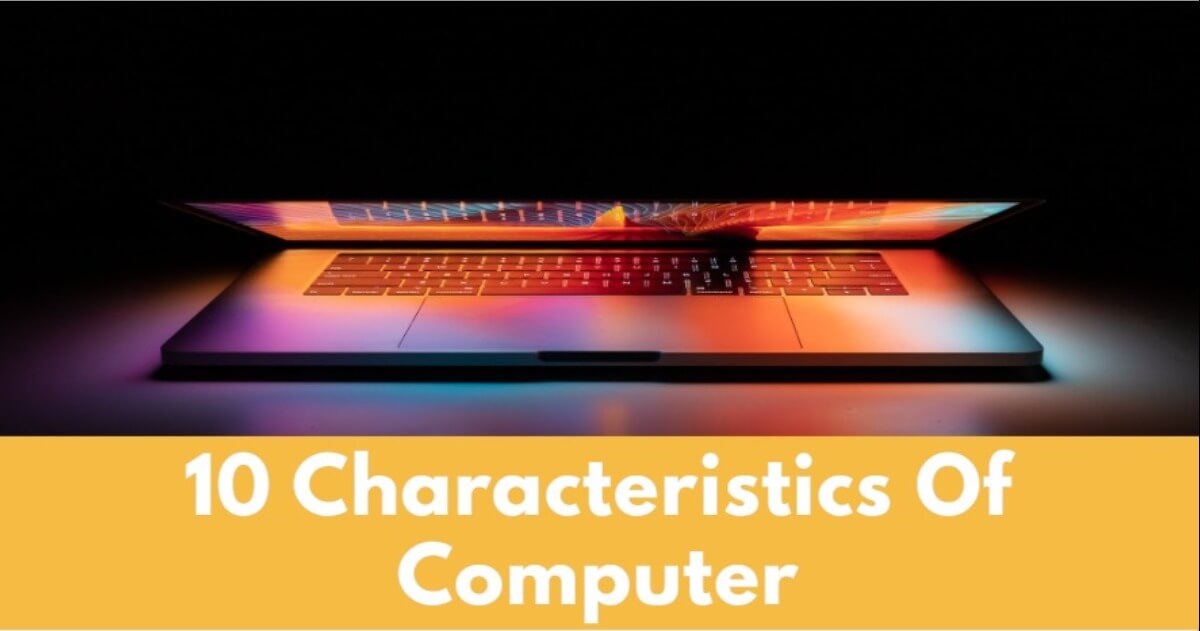What are the main features of the computer? What are the characteristics and classification of computers? This entire topic will be covered in today's article.
What is a computer?
One of the most amazing scientific discoveries in the world is the invention of the computer. It is a program-controlled electronic device that is able to work gradually and automatically. and the ability to complete mathematical and logical operations without interruption.
A computer is an advanced electrical device that takes raw data from the user as input and processes this data according to pre-given instructions (known as a program) and gives results ( output ) or stores the output for future use.
According to the Oxford Dictionary, "A computer is an electronic device for calculating or controlling any other device that stores, analyzes, and produces information."
Top characteristics of Computers:
10 Characteristics Of Computer
1. Multitasking:
Multitasking is a feature of computers that sets computers apart from other devices.
2. High Speed:
One of the characteristics of the computer is that it works incredibly fast. Its fast speed is due to the fact that it works through electrical signals, whose speed is slightly slower than the speed of light. The speed of computer operation is expressed in milliseconds, microseconds, nanoseconds, picoseconds, etc. A powerful computer can perform 3 million to 4 million or more arithmetic operations per second.
3. Correctness and Reliability:
The processing part of the computer consists of numerous delicate electrical circuits. Therefore, if a computer is given accurate data input and a correct program, it can complete any task accurately. And if the programmer inputs wrong data or instructions, the computer also gives wrong information, which is called "garbage in, garbage out." But modern computers have proven that humans make mistakes but computers don't.
4. Memory:
The computer has a huge memory. Billions of records with data and instructions can be stored in it. The computer can quickly and accurately provide the data stored in its memory to the user as soon as it receives instructions. A computer can keep large files intact in its memory for ages.
5. Logical Decision:
Computers can perform various mathematical processes as well as logical processes. It has no judicial power of its own. It is able to make decisions according to the logic provided in the program.
6. Automation:
Computers can work automatically. If the computer is given the necessary information and instructions for a task, the computer can complete the task by itself.
7. Diligence:
People cannot work for a long time. After working for a while, people get tired and take a rest. On the other hand, a natural characteristic of computers is fatigueless. Computers can work tirelessly and without rest for hours.
8. Data Processing Power:
The computer has to provide information in the form of input. After processing the data provided by its user, the computer provides the result or output based on the data. Accounting, writing, data storage, management, etc.—all kinds of work that people need—computers can do all kinds of work.
9. Sharpness:
Humans cannot always calculate accurately. Computers can perform delicate calculations. As a result, the answer to mathematical problems can be given up to more than one number after a decimal.
10. Error Testing and Debugging:
After typing a program on the computer, it is possible to run the program to test it and later determine the errors and correct them. Humans can detect mistakes, but it is often impossible to correct them immediately.
Characteristics Of Different Computer Generations
Characteristics of first-generation computers:
- Dependence.
- Memory is very small.
- Made based on vacuum tube technology.
- Very large in size, and it produces a lot of heat.
- These computers were the fastest computing devices available at the time.
- Only machine language could be understood, so the computers of this generation used to write programs in machine language.
- These computers have high mechanical disturbances, maintenance, and power consumption.
Characteristics of second-generation computers:
- Made by transistors.
- More dependent than the first generation.
- Data transfer facility.
- More capacity.
- These computers were less expensive to build.
- Small in size, high speed and low heat generation.
- Assembly language is used to write programs.
Characteristics of third-generation computers:
- invention of various advanced memory systems.
- Extensive use of Integrated Circuits or ICs.
- Power consumption is low due to small size.
- High-level programming languages were used to write programs.
Characteristics of fourth-generation computers:
- Use of VLSI technology.
- Advantages of pipeline processing.
- Small in size hence easy to transfer.
- These computers were general-purpose machines.
Characteristics of fifth-generation computers:
- Use of ULSI technology.
- Use of artificial intelligence.
- Advantages of Parallel Processing.
- Can receive data from visual input or images.
Benefits of using computers:
- A computer is a very versatile machine.
- The computer is able to do any work very fast.
- Calculations done by computers are 100% accurate.
- Every computer can be programmed into an automaton.
- Computers are also capable of giving accurate answers quickly.
- It is able to handle large amounts of data and work at high speed.
- Computer speed units are microseconds, nanoseconds, and picoseconds.
- A computer is capable of storing any kind of data. such as images, videos, text, audio, etc.
- able to perform millions of calculations in moments, which would take months to be done by a human.
- There is no shortage of speed or accuracy of the computer even if the work is done properly, as a result of which all the work is error-free.
- If you give the computer the necessary information and instructions for a task, the computer can automatically solve the task completely by itself.







0 Comments